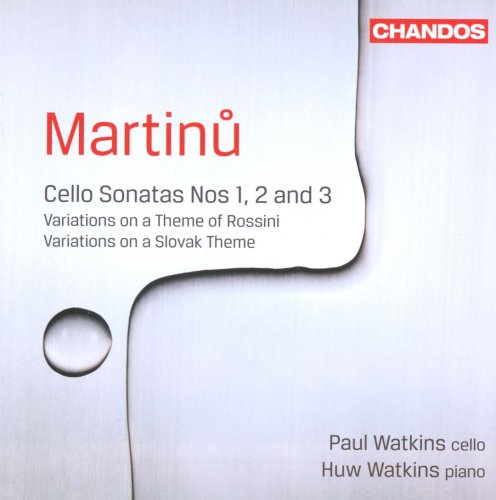Paul Watkins, Huw Watkins - Bohuslav Martinů: Cello Sonatas Nos. 1, 2 and 3 (2010)

Artist: Paul Watkins, Huw Watkins
Title: Bohuslav Martinů: Cello Sonatas Nos. 1, 2 and 3
Year Of Release: 2010
Label: Chandos Records
Genre: Classical
Quality: FLAC (image+.cue,log,scans)
Total Time: 70:15
Total Size: 298 Mb
WebSite: Album Preview
Tracklist: Title: Bohuslav Martinů: Cello Sonatas Nos. 1, 2 and 3
Year Of Release: 2010
Label: Chandos Records
Genre: Classical
Quality: FLAC (image+.cue,log,scans)
Total Time: 70:15
Total Size: 298 Mb
WebSite: Album Preview
Bohuslav Martinů (1890–1959)
[1]-[3] Sonata No.1, H 277 (1939)
for Cello and Piano
À Pierre Fournier
[4] Variations on a Slovak Theme, H 378 (1959)
for Cello and Piano
[5]-[7] Sonata No.2, H 286 (1941)
for Cello and Piano
To Frank Rybka
[8] Variations on a Theme of Rossini, H 290 (1942) in D major
for Cello and Piano
To Gregor Piatigorsky
[9]-[11] Sonata No.3, H 340 (1952) in C Major
for Cello and Piano
In memory of Hans Kindler
Performers:
Paul Watkins, cello
Huw Watkins, piano
Among his extensive chamber music output, Bohuslav Martinu left behind three magnificent cello sonatas, as well as a host of smaller works for cello and piano. Though not as extensively recorded as other standard repertoire works, there are some exemplary recordings of Martinu's sonatas, most notably the one made by Janos Starker and Rudolf Firkusný (who premiered the First Sonata with Fournier). This Chandos album features brothers Paul (cello) and Huw (piano) Watkins in what is sure to become another highly respected recording of Martinu's sonatas. The two brothers play together with seamless accuracy, carefully matching every articulation and every nuance of phrasing, dynamics, and rubato. Martinu's music relies heavily on rhythmic accuracy and intensity, and while not on the same level of fierce rhythmicity as Starker and Firkusný, the brothers Watkins are keenly sensitive to the importance of driven, clean rhythm. Paul Watkins also imparts a surprising (and very successful) focus on the lyrical aspects of Martinu's writing, particularly in the poignantly beautiful middle movements of the First and Second sonatas. Balance between the cello and piano is superb throughout, and Chandos' sound is warm, spacious, and crystal clear. Whether as an introduction to these enthralling sonatas or as an addition to an extant collection, this album is unreservedly recommended.

![Grises - Eveil (2025) [Hi-Res] Grises - Eveil (2025) [Hi-Res]](https://www.dibpic.com/uploads/posts/2025-12/1766127968_cover.jpg)






